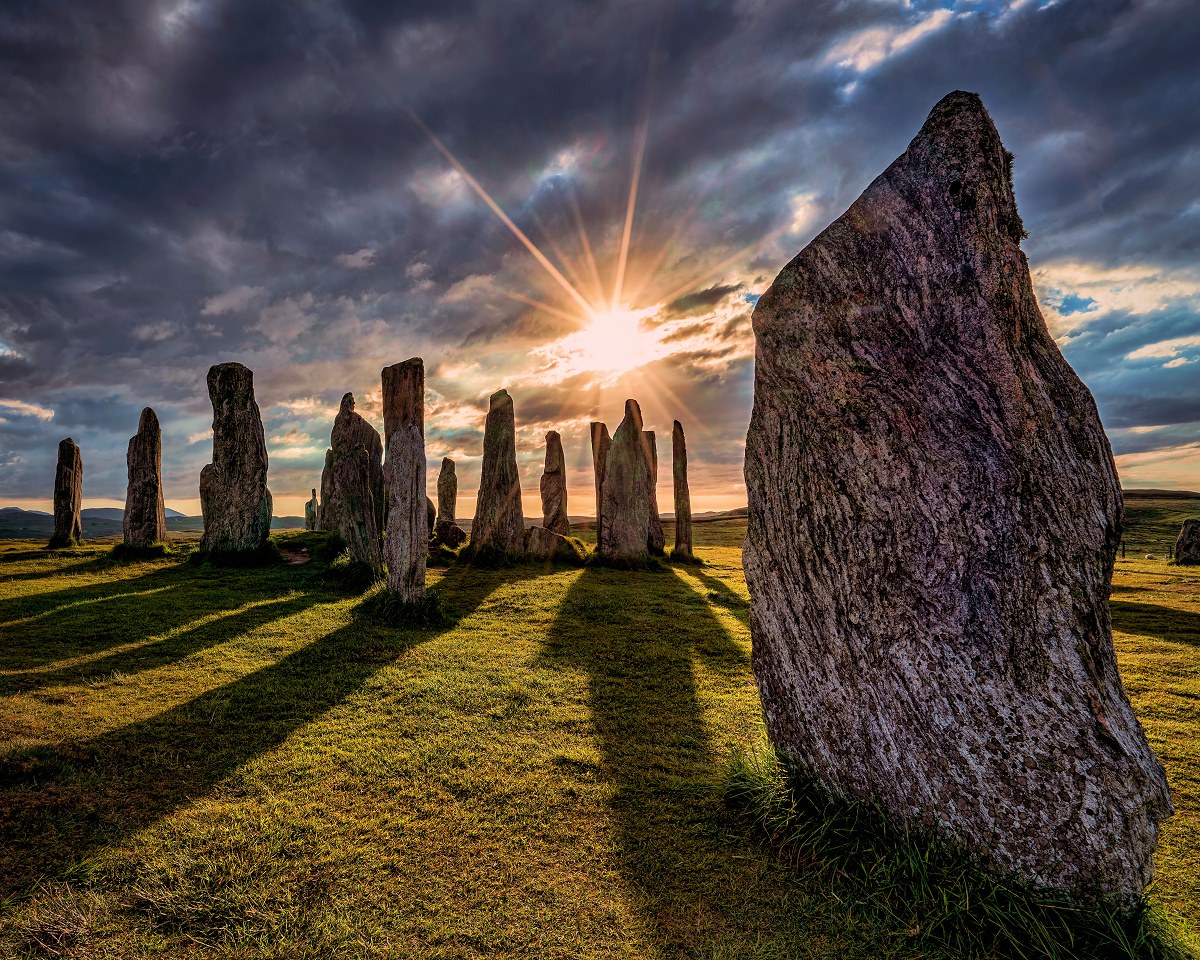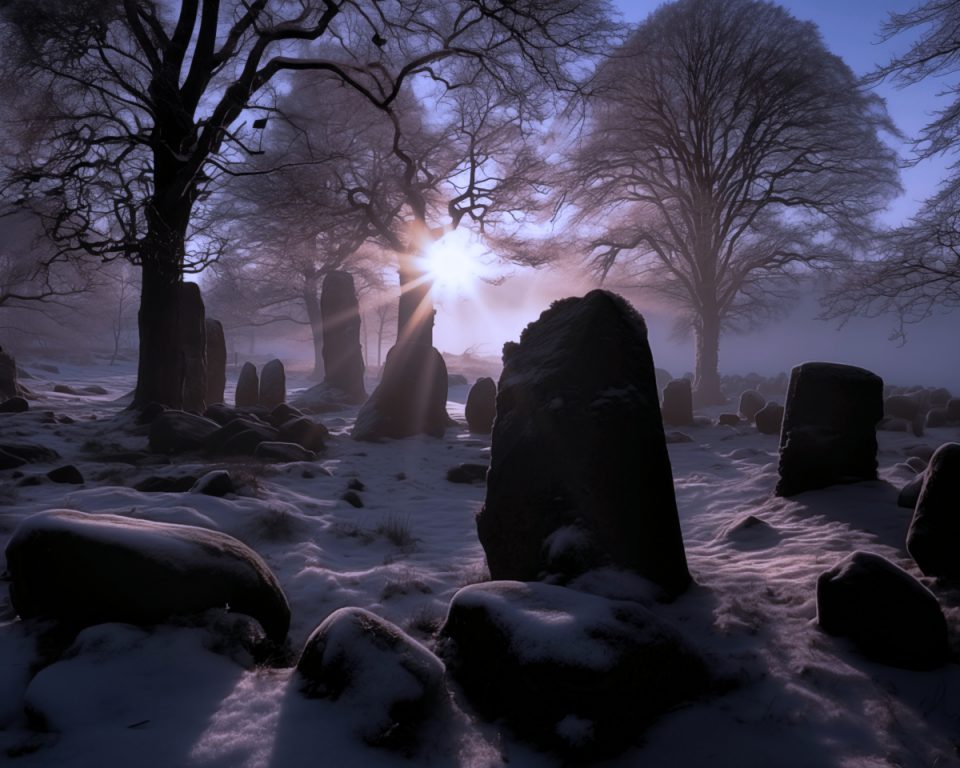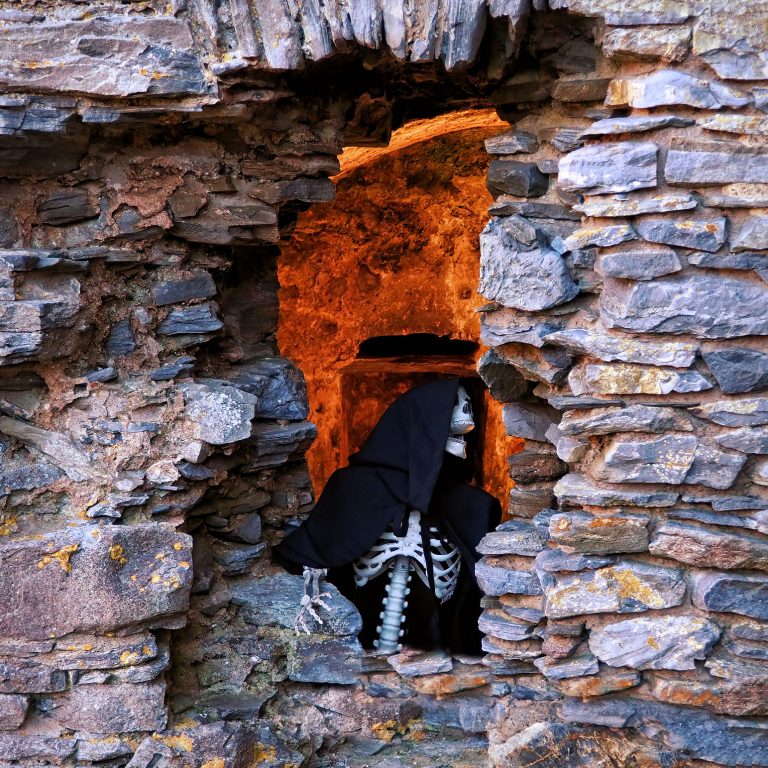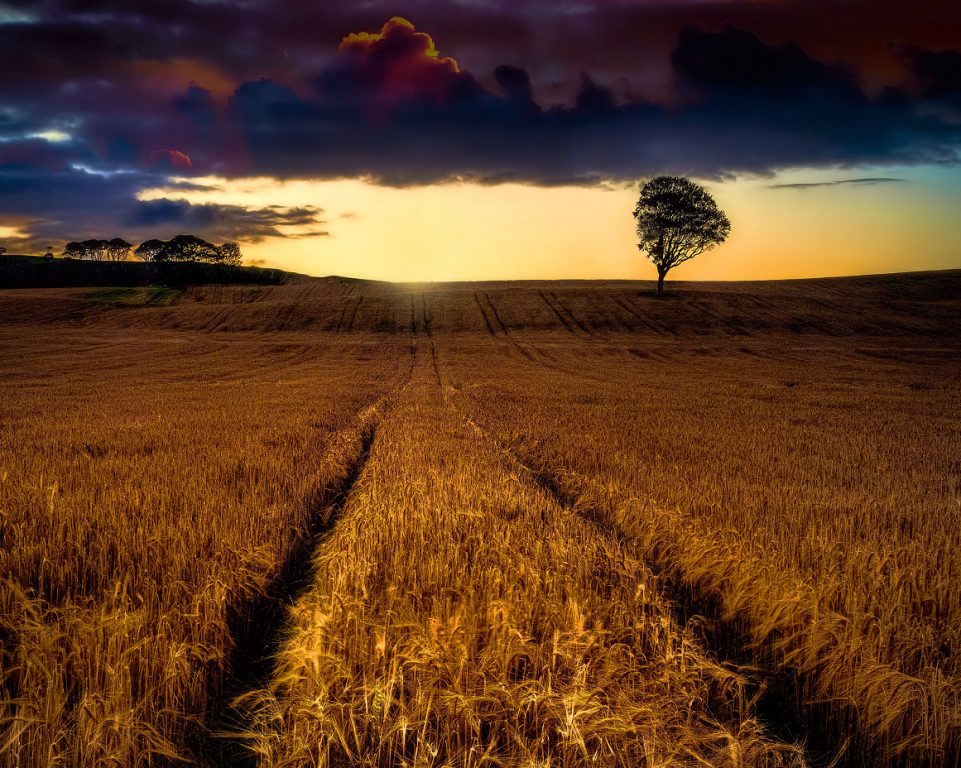The turning of the wheel of the year is something which is always with us. At the summer solstice, I stood watching the sunset at the Browland Standing Stones in Garmouth, one of the villages on the Spey Estuary. The standing stones make a four-poster circle which is an unusual stone circle configuration for the North East of Scotland.
There is something magical about the spot at the best of times. Perhaps it is the primal feeling that comes with knowing you are standing on a site which was sacred to the early peoples of Scotland, my ancestors. Or maybe it is the connection I feel with nature itself. The views are stunning. The stones are built on a ridge that overlooks the Moray Firth. On a clear day, it is possible to see the mountains of Sutherland on the other side of the water.
Views from the Browlands Stone Circle
Views extend along the coastline from the Bin of Cullen in the east to the Binn Hill in the west with all the Coastal towns and villages in between. Then there is the estuary of the River Spey itself, the fastest flowing river in Scotland, the mighty powerhouse of the Scotch whisky industry and one of Scotland’s finest salmon rivers.
From here I have watched roe deer grazing in the fields below and listened to the yellowhammers sing in the hawthorn trees. I have heard foxes barking in the darkness and watched as winter has cast its snowy pall over the land. I have seen the land turn yellow as the whins (gorse) burst into bloom at the end of winter. Also, I have watched the ebb and flow of the tide and seen the Spey burst its banks and spill over onto the floodplain below. The Spey in spate is a force to be reckoned with.
Ancient Mountains
If I follow the horizon from the Bin of Cullen it merges with Maud’s Hill with its spinning wind turbines. Following the contours south, I see the three great sentinels of the southern horizon: Knockmore, Ben Aigen and Ben Rinnes, foothills of the Cairngorm Mountain Range. The Cairngorms once stood taller than the Himalayas, but these are ancient mountains. Alas, the slow turning of time and the buffering of the cold Atlantic winds have eroded them to small shadows of their former glory.
Summer Solstice and Turning the Wheel of the Year
The days are long during the Scottish summer months and as I watch the setting solstice sun, it is close to midnight. Suddenly realisation hits me. I know why the stones have this peculiar configuration. They are a representation of the northern horizon. The two large stones mirror two of the Sutherland mountains on the other side of the firth. The smaller stones mirror the dip between the two mountains. They are aligned to the spot where the solstice sun dips below the horizon.
I stand marvelling at my discovery: I am looking at a solar observatory. I stand amazed, thinking of the early peoples who built these megaliths and their forgotten knowledge. These were not primitive ignoramuses but people who knew the principles of engineering, people who could read the skies and the cosmos and had some means of recording the movements of the heavenly bodies. How else could they know to align some of the circles to the standstill moon, an event which occurs every 18.6 years?
The Turning of the Wheel of the Year forgotten
The sun disappears and I stand in the gloaming, the twilight. It is a time for contemplation. Is humanity standing in the gloaming of our time? We have so much information at our fingertips and yet we know so little. As society has moved towards a more urbanised existence, we have become disconnected from nature, from the land and from the harvesting of our own food. Life has become fast, disjointed, and unsustainable. Our lifestyles are out of sync with the natural rhythms of the Earth. We live in a time of Climate Change, mass extinctions and plastic-filled oceans. We call this progress.
Scotland’s Early People and the Wheel of the Year
Homo sapiens, literally ‘Man who Knows’ has changed his environment more than any other species which has walked upon the face of our planet. From the moment man discovered that he could control fire, he began to make radical changes to his environment. Humans now had the ability to cook their own food, to live in colder climates and to clear the land to grow crops. However, Homo sapiens footprint in the world was small back then.
Even before the early peoples of Scotland began farming, there is evidence that they watched the solar and lunar movements in the skies and used this to form the basis of an early calendar. On the grounds of Crathes Castle, there are the remains of what is apparently a calendar built around 8,000 BC.
Importance of the First Calendar
Human communities may have been aware of the passage of time but at Crathes, something remarkable happened. Here the people had both the need and the knowledge to track time. Here a group of Hunter-Gatherers must have joined together and shared their collective knowledge of the skies and found the manpower to construct a device which would anticipate time. Why? We do not know. Perhaps it was used to predict when game would return into the area or the run of salmon on the River Dee.
Whatever its purpose, its impact on society was huge. It meant being able to schedule activities and have larger congregations of people meet together. This would have brought social change. The formal construction of time is one of man’s most important achievements. Once man developed a way to anticipate time, it had major implications for how society and civilisation would develop. Gatherings of people could be arranged at certain times when food resources were abundant. In a sense man’s ability to measure and anticipate time represents the start of history.
Neolithic Farmers and The Wheel of the Year
Then as the early Scottish people moved into the Neolithic Age is was a time of transition. They moved away from their hunter-gatherer way of life and became farmers. This had many implications for their lifestyle. As land was cleared in crop circles, permanent homes and small settlements could be built along with other permanent structures. Metalworking followed and the establishment of trading networks. Most travel would have been done by boat and it is surprising how much interaction there appears to have been between Britain and Continental Europe in pre-history times.
The growing of crops meant a reliance upon the seasons and knowledge that the crops were being planted at the correct time. The Solstices were the easiest points of the year to determine. Is this what led to the building of Stone Circles? In addition, without a compass, the early traders must have relied on the night skies to navigate by. But the skies are not static throughout the year. Those early sailors would have had to make seasonal adjustments to work out their position.
The Advent of Stone Circles
The more stable life that agriculture provided resulted in the advent of the stone circle. The building of stone circles seems to have originated in France and spread throughout Europe from there. Recent research based on statistical analysis suggests that Calanais on the Isle of Lewis along with Stenness on Orkney were the two forerunner sites for all the other standing stone monuments in Britain. The building of these stone circles marks the starting point for a ritual practice based on cosmological observation that would last for almost two millennia.
The spots where these stone circles are placed are not randomly chosen. It seems that the stones mirrored some of the geographical features of the land, such as mountain tops which aligned with certain solar and lunar events. It seems that 5,000 years ago, the ancient people of Scotland had managed to weave the sky and the land together in their stone circles to reflect the complex movements of the lunar and solar cycles at different stages. This practice was continued for at least another two millennia elsewhere in the country.
These chosen surroundings would have influenced the way the sun and the moon were seen, particularly in the timing of the rising and setting at special times like when the moon appears at its most northern position in the horizon which only happens every 18.6 years. This is known as the lunar standstill.
Winter and Summer Solstices
We know that the Stone Circles were more than just observatories as cairns began to be built and the bones of the dead were placed inside. Was this some form of ancestor worship or merely a way of placating the Gods? Some Megaliths were aligned to the Winter Solstice. These include the Stone Circles at Rothiemay and Loanhead of Daviot and the Clava Cairns near the Culloden Battlefield. However, the monument with the most famous winter solstice alignment must surely be Maeshowe in Orkney. This is the finest chambered cairn in North-West Europe and is thought to have been constructed around 2,700 B.C., making it older than Stonehenge and the Egyptian pyramids.
The recumbent stone circles of north-eastern Scotland align with the lunar standstill. The Ballochroy Standing Stones and Kist in Kintyre align with the summer solstice. Perhaps we should no longer be asking whether the Neolithic and Bronze Age communities in the British Isles integrated lunar or solar lines into some of their ritual monuments but why.
Making sense of the Wheel of the Year
With a growing dependence on the seasons and an increasing knowledge of the Cosmos, the early people tried to make sense of the world they knew. In the myths and legends of Europe, we find vestiges of primitive beliefs. Throughout Europe there was a belief in a Goddess, the Earth Mother. In Scotland, she was the Cailleach or the Carlin, the Goddess of winter, who created the world along with her nine sisters. Sometimes she was seen in opposition to Brìde the Goddess of spring. However, in some tales she is portrayed as a dual being, turning into Brìde in the spring. The Cailleach was said to rule between Samhain and Beltane, whereas Brìde presided over the months between Beltane and Samhain. These significant farming events in the Wheel of the year.
The Formation of the Quarter Days
Eventually, important times in the farming year were marked as the Gaelic quarter-days. These occurred halfway between the solstices and equinoxes.
These were:
SAMHAIN (October 31)
Samhain (SOW-in) represents the final harvest before the long winter. It signalled the return of Cailleach. However, it has now been replaced by Halloween and All Saints Day
IMBOLC / CANDLEMAS (February 2)
Imbolc is a festival of fire and light, and a time of celebrating the goddess Brìde who would soon return. It was an important time of the year agriculturally as this was when the sheep began to give birth.
BELTANE / MAY DAY (May 1)
Beltane is a spring celebration that honours the fertility of the earth. This was the time when Brìde returns. It is a time when the crops grow and when hay is made.
LUGHNASADH / LAMMAS (August 1)
Lughnasadh (LOO-na-saa) is a celebration in honour of the Celtic god, Lugh. It celebrates the start of the harvest.
Quarter Day Rituals
Later the quarter-day festivals would become the four divisions of the legal year, historically used as the days when contracts and leases would begin and end, servants would be hired or dismissed, and rent, interest on loans, and ministers’ stipends would become due.
In Scotland, there were many traditions associated with quarter-days. Many of these rituals were carried out to protect the harvest and the wellbeing of their livestock. As well as performing rituals such as saining, the quarter-days were feast days. Bonfires would be lit and wells would be dressed. Even today fire festivals take place at various times of the year.
In modern times, many of the old ways are being lost. Alas, with increased urbanisation, the connection people once had with the land, the passing of the seasons and the turning of the cosmos is becoming increasingly tenuous
The Importance of the Wheel of the Year in Modern Day Society
The turning of the wheel of the year is a circle, one of the cycles which govern life. It is the changing of the seasons, the passing of time. People know more about the cycles which govern life on Earth than at any other time in Earth’s history. For instance, we know about the rock cycle which will eventually erode the Cairngorms to a flat plain. We know about the carbon and oxygen cycles. We know how the Earth’s rotation and its position relative to the sun creates the seasons. But do we apply that knowledge wisely?
The early people applied their knowledge wisely. It was the difference between life and death. Sustainable farming methods were important as they needed to eat. What of us? Have our roles and knowledge in society become too specialised? Has our collective knowledge become too disjointed? Even our agricultural methods are so far removed from the days where farms supported only the local community. We now eat foods out of season and have also manipulated our crops to grow out of season.
For most of us, our reality is far removed from the harvesting of our food, the life-giving sustenance that supports us and gives us life. Without that connection to the land and nature, have we become so far removed from the Earth’s lifegiving processes that we think only in terms of commodities and satisfying our present wants. But have we forgotten that future generations must follow behind us? Have we no thought for the other species we co-exist with on our planet? I fear that the legacy we will leave behind will not be the mysterious stone circles which dot the land but the dire consequences of a people who heard the word ‘sustainability’ and chose to ignore it.
Please feel free to share the spooky by using the links below or leave us a message in the comments box.




